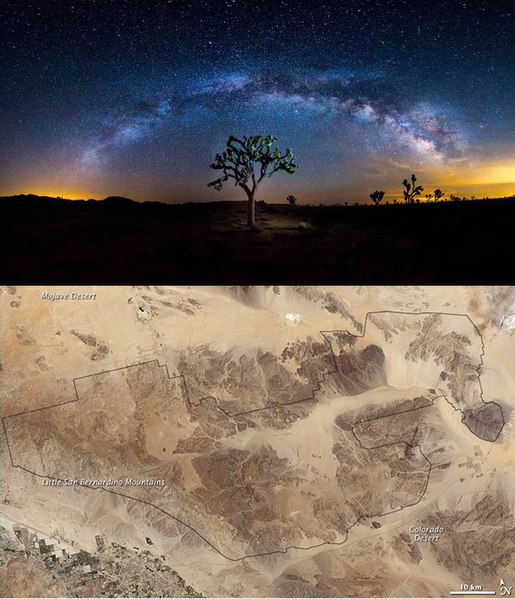File:Ground to Space- Joshua Tree National Park.jpg

Original file (598 × 696 pixels, file size: 167 KB, MIME type: image/jpeg)
Captions
Captions
Summary edit
| DescriptionGround to Space- Joshua Tree National Park.jpg |
English: On October 16, 2015, the U.S. Department of Interior tweeted this lovely photograph (top image) of the Milky Way over a Joshua tree (yucca brevifolia) in Joshua Tree National Park. The photograph, which was taken by Manish Mamtani, prompted us to dig out the satellite image (lower image) from our archives.
When Joshua Tree National Park was first proposed for preservation in the 1930s, the suggested name was “Desert Plants National Park,” because of the 700 plant species, including cacti and succulents, wildflowers, desert palms, and hardy shrubs that manage to survive in the desert climate. The plants support the park’s wildlife, among them 25 species of snakes; mammals such as bighorn sheep, ground squirrels, and coyotes; hundreds of migratory and resident birds; and thousands of species of insects and arthropods, including tarantulas, fairy shrimp, scorpions, and more than 150 species of butterflies and moths. From space, all this biodiversity is far less visible than it is on the ground, but the reason for the diversity is apparent in this Landsat satellite image captured on May 28, 2003. The high levels of biodiversity are the result of the adaptation of plants and animals to three major topographic and climatic zones that meet in the park. The north-northeast part of the park intersects the southern edge of the Mojave Desert, which is higher in elevation and slightly cooler and wetter than the Colorado Desert areas in the eastern and southern parts of the park. A third topographic zone is provided by high altitudes (above 4,000 feet) of the Little San Bernardino Mountains at the far western edge of the park. Natural springs, forced to the surface near geologic faults, also create five rare desert palm oases in the western part of the park. Ultimately, the park was given the name of its largest, most iconic, plant resident: Yucca brevifolia, nicknamed the “Joshua tree” by European settlers. Rangers have described the plant as the "canteen of the desert" because its tissues hold water during dry spells. Although its spiny leaves and thick bark discourage all but the thirstiest animals, the living tissue of a Joshua tree is often the last source of moisture for animals during times of extreme drought. See the U.S. Department of Interior tweet at go.nasa.gov/1M9xmr8 Download a large version of the satellite image at go.nasa.gov/1M9xmrc |
| Date | |
| Source | https://www.flickr.com/photos/68824346@N02/21745852414/ |
| Author | NASA Earth Observatory |
Licensing edit
- You are free:
- to share – to copy, distribute and transmit the work
- to remix – to adapt the work
- Under the following conditions:
- attribution – You must give appropriate credit, provide a link to the license, and indicate if changes were made. You may do so in any reasonable manner, but not in any way that suggests the licensor endorses you or your use.
| This image was originally posted to Flickr by NASA Earth Observatory at https://flickr.com/photos/68824346@N02/21745852414. It was reviewed on 25 October 2020 by FlickreviewR 2 and was confirmed to be licensed under the terms of the cc-by-2.0. |
25 October 2020
File history
Click on a date/time to view the file as it appeared at that time.
| Date/Time | Thumbnail | Dimensions | User | Comment | |
|---|---|---|---|---|---|
| current | 12:37, 25 October 2020 |  | 598 × 696 (167 KB) | Kroger4 (talk | contribs) | Uploaded a work by NASA Earth Observatory from https://www.flickr.com/photos/68824346@N02/21745852414/ with UploadWizard |
You cannot overwrite this file.
File usage on Commons
There are no pages that use this file.
Metadata
This file contains additional information such as Exif metadata which may have been added by the digital camera, scanner, or software program used to create or digitize it. If the file has been modified from its original state, some details such as the timestamp may not fully reflect those of the original file. The timestamp is only as accurate as the clock in the camera, and it may be completely wrong.
| Software used | Adobe Photoshop CS6 Macintosh |
|---|